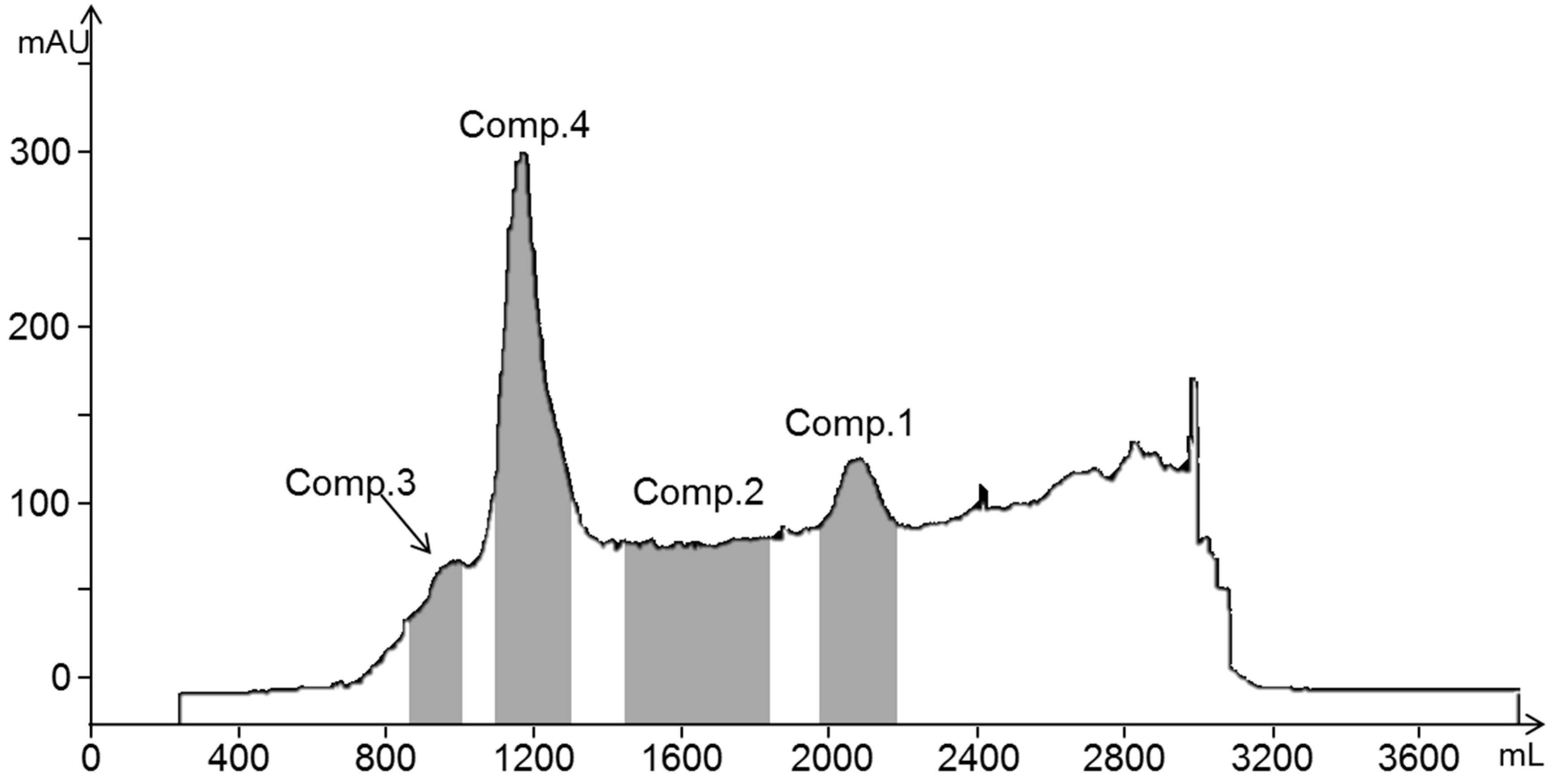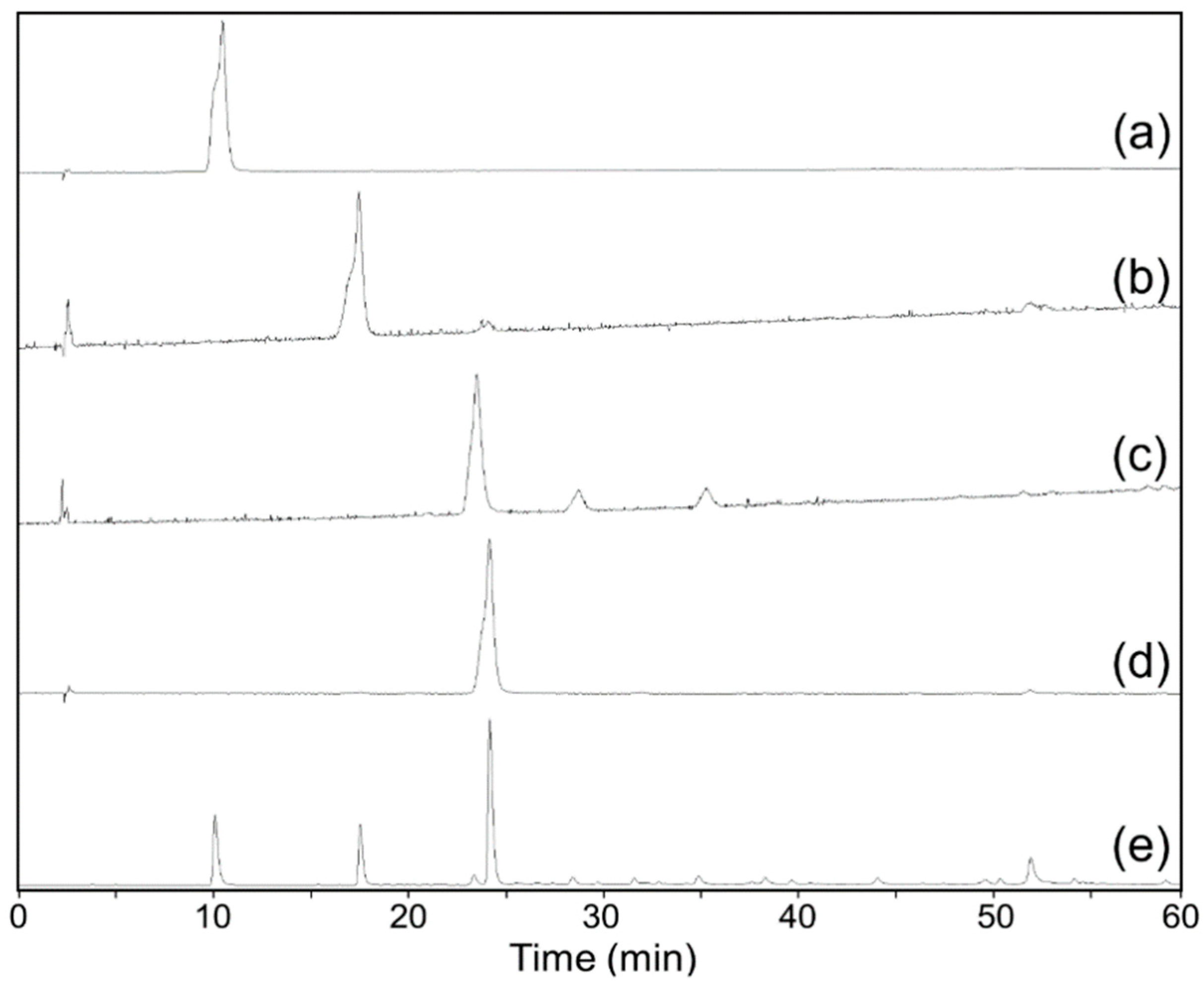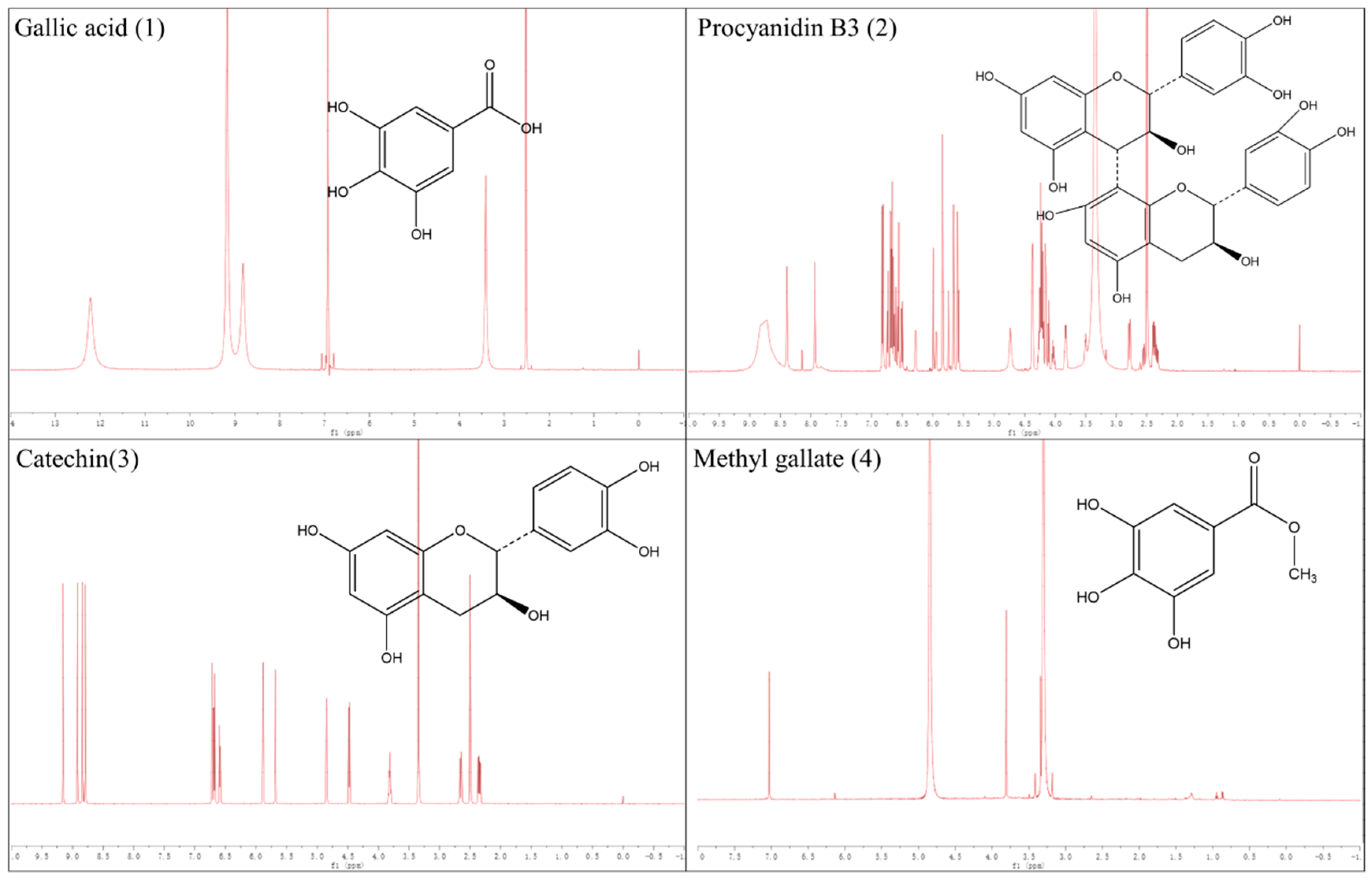Screening and Isolating Major Aldose Reductase Inhibitors from the Seeds of Evening Primrose (Oenothera biennis)
Abstract
1. Introduction
2. Results and Discussion
2.1. Rat Lens AR (RLAR) Inhibitory Effects of Evening Primrose Seed Extract
2.2. Screening of Potential ARIs from the EME
2.3. HSCCC Separation of Potential ARIs from EME
2.4. RLAR Inhibitory Activities of the Isolated Compounds
3. Materials and Methods
3.1. Reagents and Materials
3.2. Extraction and Fractionation of Evening Primrose Seeds
3.3. Animals
3.4. Determination of RLAR Activity
3.5. Ultrafiltration Procedures
3.6. HPLC Conditions
3.7. Separation by HSCCC
3.8. H NMR Spectroscopy of the Isolated Compounds
4. Conclusions
Author Contributions
Funding
Conflicts of Interest
References
- (International Diabetes Federation.) Diabetes Atlas, 7th Edition. Available online: http://www.idf.org/diabetesatlas. (accessed on 6 September 2015).
- Jain, S.; Saraf, S. Type 2 diabetes mellitus–Its global prevalence and therapeutic strategies. Diabetes Metab. Syndr. 2010, 4, 48–56. [Google Scholar] [CrossRef]
- Brownlee, M. Biochemistry and molecular cell biology of diabetic complications. Nature 2001, 414, 813–820. [Google Scholar] [CrossRef] [PubMed]
- Fowler, M.J. Microvascular and macrovascular complications of diabetes. Clin. Diabetes 2008, 26, 77–82. [Google Scholar] [CrossRef]
- American Diabetes Association. Diagnosis and classification of diabetes mellitus. Diabetes Care 2013. [Google Scholar] [CrossRef]
- Gleissner, C.A.; Galkina, E.; Nadler, J.L.; Ley, K. Mechanisms by which diabetes increases cardiovascular disease. Drug Discov. Today Dis. Mech. 2007, 4, 131–140. [Google Scholar] [CrossRef] [PubMed]
- UK Prospective Diabetes Study (UKPDS) Group. Intensive blood-glucose control with sulphonylureas or insulin compared with conventional treatment and risk of complications in patients with type 2 diabetes (UKPDS 33). Lancet 1998, 352, 837–853. [Google Scholar] [CrossRef]
- Brownlee, M. The pathobiology of diabetic complications: A unifying mechanism. Diabetes 2005, 54, 1615–1625. [Google Scholar] [CrossRef] [PubMed]
- Rittner, H.L.; Hafner, V.; Klimiuk, P.A.; Szweda, L.I.; Goronzy, J.J.; Weyand, C.M. Aldose reductase functions as a detoxification system for lipid peroxidation products in vasculitis. J. Clin. Invest. 1999, 103, 1007–1013. [Google Scholar] [CrossRef] [PubMed]
- Wilson, D.K.; Bohren, K.M.; Gabbay, K.H.; Quiocho, F.A. An unlikely sugar substrate site in the 1.65 A structure of the human aldose reductase holoenzyme implicated in diabetic complications. Science 1992, 257, 81–84. [Google Scholar] [CrossRef]
- Maccari, R.; Ottanà, R. Targeting aldose reductase for the treatment of diabetes complications and inflammatory diseases: New insights and future directions. J. Med. Chem. 2015, 58, 2047–2067. [Google Scholar] [CrossRef]
- Chang, K.C.; Snow, A.; LaBarbera, D.V.; Petrash, J.M. Aldose reductase inhibition alleviates hyperglycemic effects on human retinal pigment epithelial cells. Chem. Biol. Interact. 2015, 234, 254–260. [Google Scholar] [CrossRef] [PubMed]
- Alexiou, P.; Pegklidou, K.; Chatzopoulou, M.; Nicolaou, I.; Demopoulos, V.J. Aldose reductase enzyme and its implication to major health problems of the 21st century. Curr. Med. Chem. 2009, 16, 734–752. [Google Scholar] [CrossRef] [PubMed]
- Costantino, L.; Rastelli, G.; Vianello, P.; Cignarella, G.; Barlocco, D. Diabetes complications and their potential prevention: Aldose reductase inhibition and other approaches. Med. Res. Rev. 1999, 19, 3–23. [Google Scholar] [CrossRef]
- Miyamoto, S. Molecular modeling and structure-based drug discovery studies of aldose reductase inhibitors. Chem. Bio. Inform. J. 2002, 2, 74–85. [Google Scholar] [CrossRef][Green Version]
- Suzen, S.; Buyukbingol, E. Recent studies of aldose reductase enzyme inhibition for diabetic complications. Curr. Med. Chem. 2003, 10, 1329–1352. [Google Scholar] [CrossRef] [PubMed]
- Bhatnagar, A.; Srivastava, S.K. Aldose reductase: Congenial and injurious profiles of an enigmatic enzyme. Biochem. Med. Metab. Biol. 1992, 48, 91–121. [Google Scholar] [CrossRef]
- Pfeifer, M.A.; Schumer, M.P.; Gelber, D.A. Aldose reductase inhibitors: The end of era or the need for different trial designs? Diabetes 1997. [Google Scholar] [CrossRef] [PubMed]
- Briggs, C.J. Evening primrose. Can. Pharm. 1986, 119, 249–254. [Google Scholar]
- Wettasinghe, M.; Shahidi, F.; Amarowicz, R. Identification and quantification of low molecular weight phenolic antioxidants in seeds of evening primrose (Oenothera biennis L.). J. Agr. Food Chem. 2002, 50, 1267–1271. [Google Scholar] [CrossRef]
- Montserrat-de la Paz, S.; Fernández-Arche, M.A.; Bermúdez, B.; García-Giménez, M.D. The sterols isolated from evening primrose oil inhibit human colon adenocarcinoma cell proliferation and induce cell cycle arrest through upregulation of LXR. J. Funct. Foods 2015, 12, 64–69. [Google Scholar] [CrossRef][Green Version]
- Montserrat-de la Paz, S.; Fernandez-Arche, M.A.; Ángel-Martín, M.; García-Giménez, M.D. The sterols isolated from evening primrose oil modulate the release of proinflammatory mediators. Phytomedicine 2012, 19, 1072–1076. [Google Scholar] [CrossRef] [PubMed]
- Gorlach, S.; Wagner, W.; Podsędek, A.; Sosnowska, D.; Dastych, J.; Koziołkiewicz, M. Polyphenols from evening primrose (Oenothera paradoxa) defatted seeds induce apoptosis in human colon cancer caco-2 cells. J. Agr. Food Chem. 2011, 59, 6985–6997. [Google Scholar] [CrossRef] [PubMed]
- Pająk, P.; Socha, R.; Broniek, J.; Królikowska, K.; Fortuna, T. Antioxidant properties, phenolic and mineral composition of germinated chia, golden flax, evening primrose, phacelia and fenugreek. Food Chem. 2019, 275, 69–76. [Google Scholar] [CrossRef] [PubMed]
- Ito, Y. Golden rules and pitfalls in selecting optimum conditions for high-speed counter-current chromatography. J. Chromatogr. A 2005, 1065, 145–168. [Google Scholar] [CrossRef] [PubMed]
- Kiss, A.K.; Derwińska, M.; Granica, S. Quantitative analysis of biologically active polyphenols in evening primrose (Oenothera paradoxa) seeds aqueous extracts. Pol. J. Food Nutr. Sci. 2011, 61, 109–113. [Google Scholar] [CrossRef]




| Samples | Inhibition (%) 1 | IC50 2 |
|---|---|---|
| Hexane extract | 24.19 ± 8.48 4 | - 5 |
| 50% (v/v) Methanol extract | 80.88 ± 2.02 | 7.53 ± 1.67 μg/mL |
| Ethyl acetate fraction of 50% (v/v) methanol extract (EME) | 88.58 ± 4.36 | 3.08 ± 0.84 μg/mL |
| Water fraction of 50% (v/v) methanol extract | 46.20 ± 3.24 | |
| Quercetin 3 | 81.57 ± 3.81 | 0.54 ± 0.13 μg/mL |
| Solvent System (v/v/v) | K Values of Compounds | |||||||||||||
|---|---|---|---|---|---|---|---|---|---|---|---|---|---|---|
| 1 1 | 2 | 3 | 4 | 5 | 6 | 7 | 8 | 9 | 10 | 11 | 12 | 13 | 14 | |
| HE/EA/ME/WA (1/3/0/4) | 4.12 | 0.75 | 13.26 | 5.58 | 0.01 | 1.41 | 1.31 | 6.43 | 2.84 | 1.46 | 4.43 | 0.13 | 0.15 | 0.98 |
| HE/EA/ME/WA (1/5/1/5) | 2.23 | 0.57 | 0.20 | 0.44 | 0.26 | 3.32 | 0.30 | 2.64 | 2.09 | 2.92 | 1.69 | 1.55 | 0.39 | 0.58 |
| HE/EA/ME/WA (1.25/5/1.25/5) | 2.41 | 0.66 | 0.26 | 0.57 | 0.24 | 4.65 | 0.51 | 5.98 | 7.94 | 7.89 | 5.67 | 4.77 | 0.35 | 1.14 |
| HE/EA/ME/WA (1.5/5/1.5/5) | 3.13 | 0.90 | 0.31 | 0.66 | 0.25 | 8.86 | 0.22 | 9.85 | 12.49 | 13.85 | 6.59 | 4.93 | 0.44 | 1.36 |
| HE/EA/ME/WA (1.75/5/1.75/5) | 3.59 | 0.94 | 0.34 | 0.73 | 0.35 | 8.27 | 0.22 | 9.25 | 12.17 | 25.61 | 6.95 | 5.23 | 0.48 | 1.44 |
| HE/EA/ME/WA (2/5/2/5) | 4.25 | 1.11 | 0.35 | 0.84 | 0.37 | 8.81 | 0.36 | 12.06 | 8.83 | 12.00 | 11.09 | 6.17 | 0.59 | 2.31 |
| Samples | Inhibition (%) 1 | IC50 2 |
|---|---|---|
| Gallic acid (1) | 80.25 ± 1.56 4 | 11.46 ± 1.82 μmol/L |
| Procyanidin B3 (2) | 44.61 ± 1.99 | - 5 |
| Catechin (3) | 69.57 ± 1.99 | 14.78 ± 3.17 μmol/L |
| Methyl gallate (4) | 32.22 ± 0.97 | |
| Quercetin 3 | 81.57 ± 3.81 | 1.79 ± 0.43 μmol/L |
© 2019 by the authors. Licensee MDPI, Basel, Switzerland. This article is an open access article distributed under the terms and conditions of the Creative Commons Attribution (CC BY) license (http://creativecommons.org/licenses/by/4.0/).
Share and Cite
Wang, Z.; Shen, S.; Cui, Z.; Nie, H.; Han, D.; Yan, H. Screening and Isolating Major Aldose Reductase Inhibitors from the Seeds of Evening Primrose (Oenothera biennis). Molecules 2019, 24, 2709. https://doi.org/10.3390/molecules24152709
Wang Z, Shen S, Cui Z, Nie H, Han D, Yan H. Screening and Isolating Major Aldose Reductase Inhibitors from the Seeds of Evening Primrose (Oenothera biennis). Molecules. 2019; 24(15):2709. https://doi.org/10.3390/molecules24152709
Chicago/Turabian StyleWang, Zhiqiang, Shigang Shen, Ze Cui, Hailiang Nie, Dandan Han, and Hongyuan Yan. 2019. "Screening and Isolating Major Aldose Reductase Inhibitors from the Seeds of Evening Primrose (Oenothera biennis)" Molecules 24, no. 15: 2709. https://doi.org/10.3390/molecules24152709
APA StyleWang, Z., Shen, S., Cui, Z., Nie, H., Han, D., & Yan, H. (2019). Screening and Isolating Major Aldose Reductase Inhibitors from the Seeds of Evening Primrose (Oenothera biennis). Molecules, 24(15), 2709. https://doi.org/10.3390/molecules24152709





